Table of Contents
Beans are a superfood for those seeking a healthy diet. Over 100 types of beans, including black, red, pinto, lima, chickpeas, and cannellini, are grown worldwide.
Particularly, in people with diabetes, what to eat becomes more important as they need to carefully choose foods with high protein content, rich in fiber, and low glycemic index.
People with diabetes should be careful about their portions and food selection. As a general rule, diabetics must get enough nutrition to supply the body’s daily requirements while keeping blood sugar levels within their target range.
To get a thorough answer to the question, ” Are beans good for diabetics? “, we will explore the different types of beans, their health benefits, and how their consumption can positively impact people with diabetes. Keep reading to learn all about this amazing food.
Can diabetics eat beans?
Beans are high-nutrient foods that are easy to find and inexpensive. They are usually found in different forms, such as dry beans, canned beans, precooked beans, frozen beans, and vacuum-packed beans. Each has advantages and disadvantages, but as a general rule, people with diabetes should consume foods with no added sugar or sodium.
People with diabetes should include foods rich in protein, fiber, and minerals in their diet and limit high simple carbohydrates or high glycemic index foods. Numerous foods meet these criteria in varying proportions, offering nutritious and suitable options for those managing diabetes. These foods include:
- Vegetables: non-starchy vegetables, such as salad greens, green beans, broccoli, cauliflower, cabbage, and carrots.
- Foods high in lean protein, such as chicken, turkey, beans, tofu, or eggs.
- Foods high in carbohydrates include grains, starchy vegetables (such as potatoes), rice, pasta, beans, peas, fruits, and yogurt.
It is highly recommended that people with diabetes include beans in their diet. Medical guidelines suggest that approximately 1/4 of the portion on the plate should consist of carbohydrates, either from rice, beans, or other similar foods (1).
Benefits of beans for people with diabetes
Beans, in particular, offer several significant health benefits for diabetics thanks to their great nutritional profile. Here are some profound benefits of beans for people with diabetes:
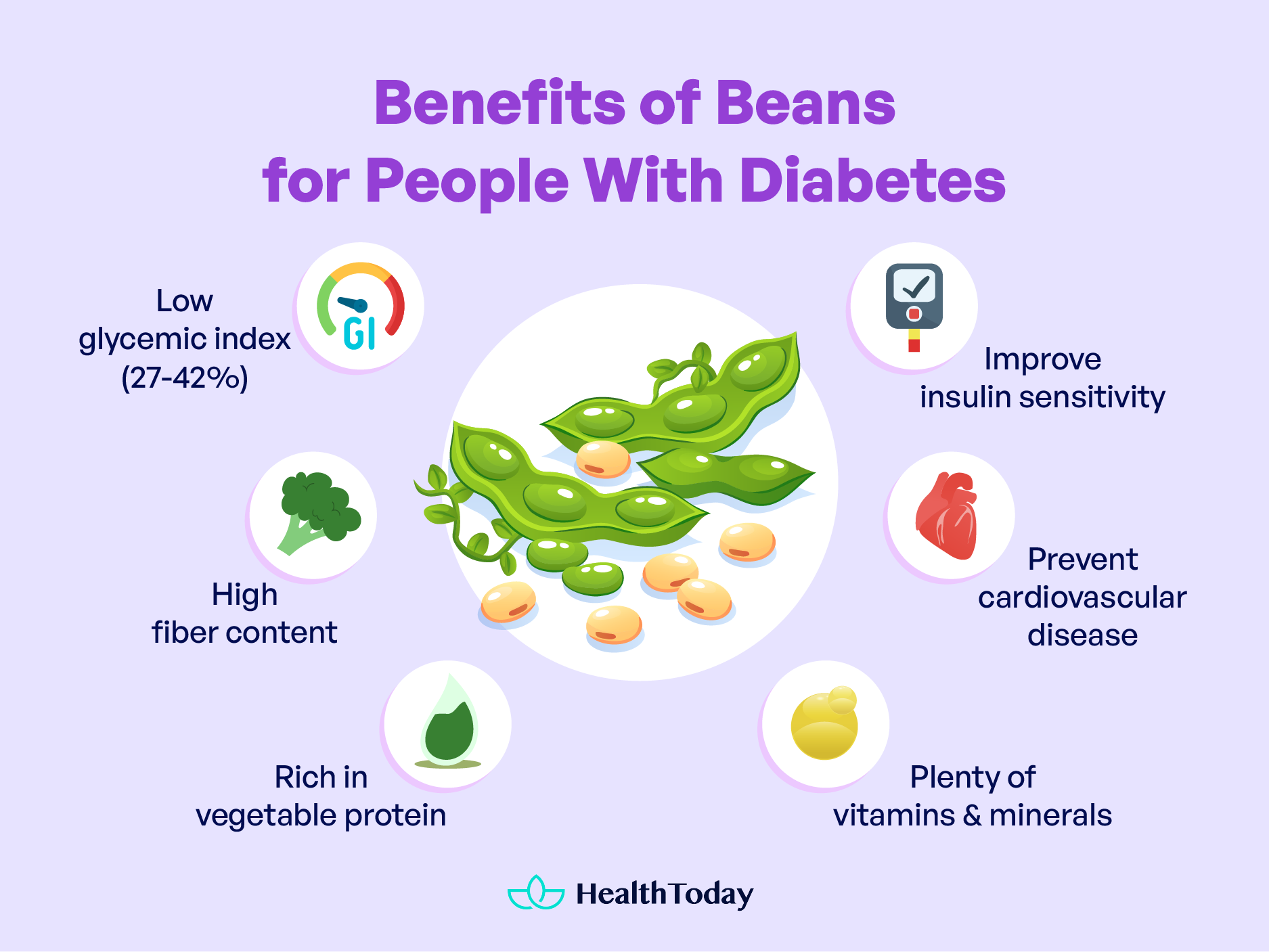
Low glycemic index
The glycemic index is a tool to evaluate how a food affects blood sugar levels compared to a control, typically glucose or white bread. It is classified into three categories: low (<55), medium (56-69), and high (70 or higher).
Typically, the higher the index level, the more the food is bad for diabetics and should be avoided as it quickly turns to sugar and can cause blood sugar spikes.
Beans generally have a low glycemic index, ranging from 27% to 42%. This range suggests that their impact on blood sugar levels is gradual and slower, which is beneficial for glycemic control in people with diabetes (2).
It is important to note that baked beans, canned beans, and black-eyed beans tend to have a higher glycemic index among other bean varieties. Therefore, consuming these types in moderation is recommended, especially for those seeking to control their blood sugar levels.
High fiber content
Beans are high in dietary fiber, which comes in soluble and insoluble forms. Fiber plays a key role in slowing the digestion and absorption of carbohydrates, preventing rapid spikes in blood sugar levels (3).
In addition to its direct impact on blood glucose, fiber also offers other significant health benefits (4):
- Improves satiety: This helps regulate eating habits and prevents weight gain.
- Reduces bad cholesterol: Multiple research suggests that soluble fiber consumption can help reduce LDL (“bad”) cholesterol levels, contributing to cardiovascular health and reducing the risk of heart disease.
Rich in vegetable protein
Beans are a great source of plant-based protein, which helps stabilize blood sugar levels. The American Diabetes Association states that ½ cup of beans provides as much protein as an ounce of meat without saturated fat (5).
Nutritional quality
Beans are a source of nutrients, with plenty of vitamins and minerals, and low in trans fat, salt, and cholesterol. Some essential vitamins and minerals in beans are folate, iron, potassium, magnesium, and calcium.
Cardiovascular benefits
The leading cause of mortality in patients with diabetes is cardiovascular disease. Beans, rich in fiber, potassium, magnesium, and vegetable proteins, play a fundamental role in preventing these diseases and contribute to the maintenance of overall cardiovascular health (6).
Regulation of insulin sensitivity
Some studies suggest that consumption of legumes, including beans, may improve insulin sensitivity, potentially helping people with diabetes better utilize insulin to regulate glucose (7).
Beans stand out as a highly nutritious food and are recommended to be included in the diet of people with diabetes. Their low glycemic index, high fiber, and high-quality protein content can help prevent cardiovascular disease, the leading cause of mortality in people with diabetes.
Do beans have sugar? Bean’s nutrition facts
Beans contain carbohydrates, including sugars, fiber, and starches. However, the sugar content in beans is usually natural sugars, and their carbohydrate profile is considered healthy.
With over 100 kinds of beans, the nutritional values of beans can vary. Although most are similar, we will use red kidney beans, a common variety of the common bean (Phaseolus vulgaris), native to Central America and Mexico, as a reference.
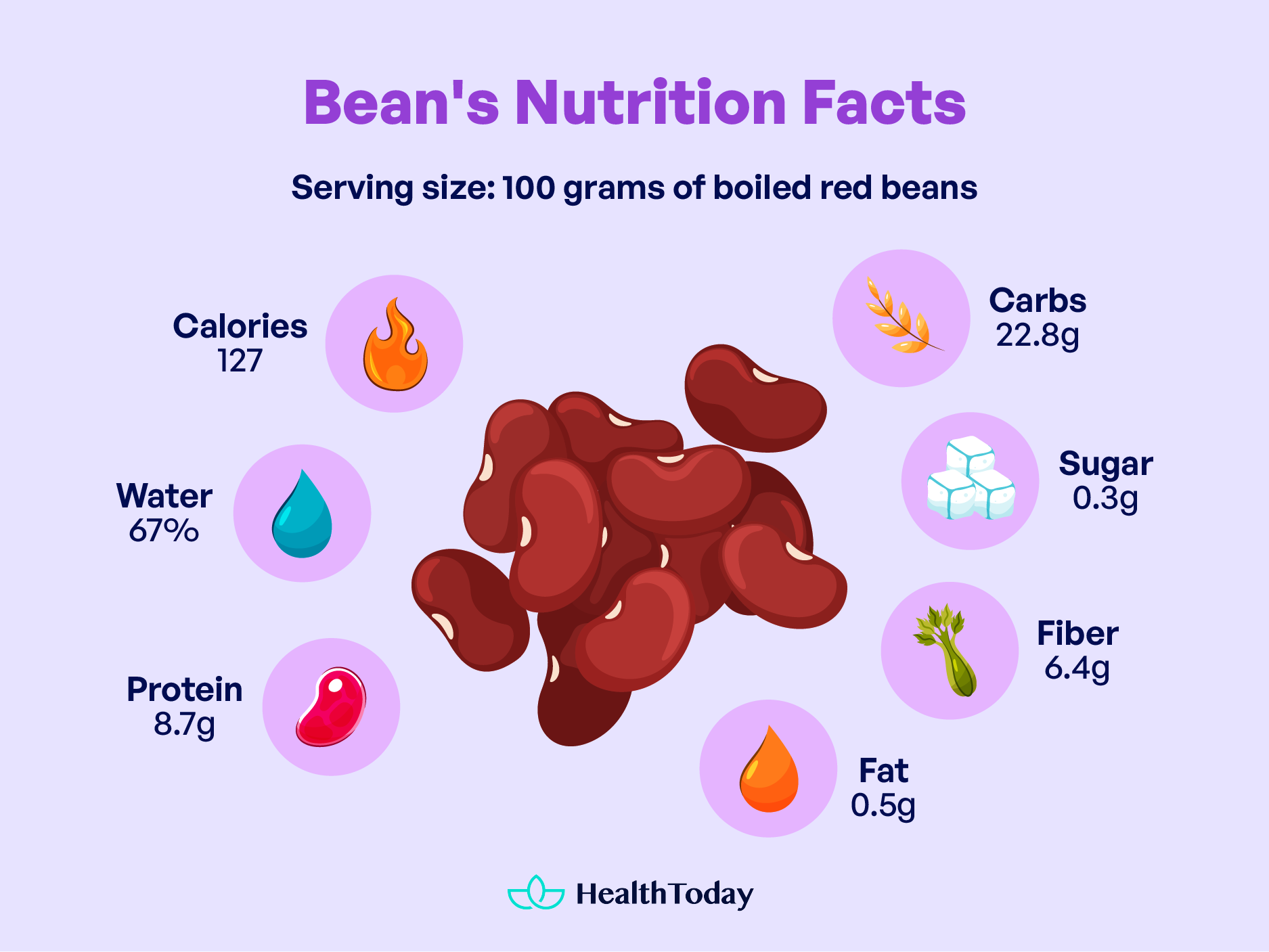
For every 100 grams of boiled red beans, we obtain the following nutritional data (7):
- Calories: 127
- Water: 67%
- Protein: 8.7 grams
- Carbs: 22.8 grams
- Sugar: 0.3 grams
- Fiber: 6.4 grams
- Fat: 0.5 grams
This indicates that kidney beans are highly nutritious, providing 127 calories per 100 grams. Their high water content is beneficial for organs such as the skin. In addition, they are rich in carbohydrates and quality proteins, with low levels of sugar and fat —mostly unsaturated and high-quality fat, unlike saturated fats in foods of animal origin.
Types of beans for diabetics: What you should know
Beans, with their numerous health benefits and versatility, are an excellent addition to a well-balanced diet for people with diabetes. We will divide them according to their glycemic index to help clarify which beans to choose (8, 9).
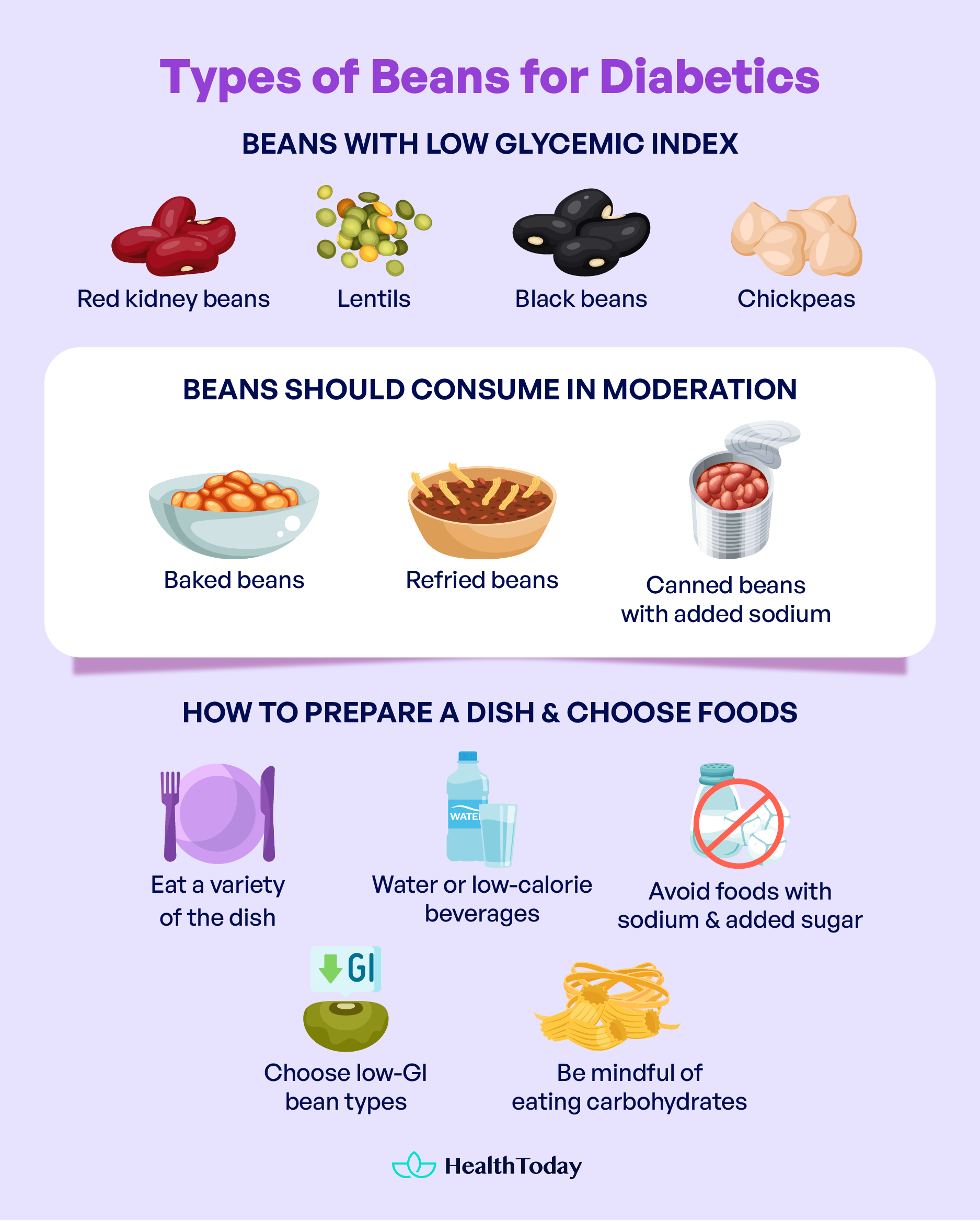
Beans with low glycemic index
- Red kidney beans: These beans are among the most consumed beans. Reddish in color, red kidney beans are rich in fiber and have a low GI. They are also a good source of protein and provide minerals such as magnesium and potassium.
- Lentils: Lentils are low in calories, high in fiber, and rich in protein. They have a minimal impact on blood sugar levels, making them an excellent choice for diabetics.
- Black beans: These beans are high in fiber, protein, and antioxidants. They have a low GI and provide steady energy without causing a rapid rise in blood sugar levels. In addition, black beans also contain essential nutrients such as folate, iron, and magnesium.
- Chickpeas: Chickpeas are fiber-rich legumes with a low GI. They are also a good source of protein, folic acid, and iron.
Beans you should consume in moderation
- Baked beans: Baked beans (often containing white beans) have added sugar or syrup, which are not recommended for people with diabetes. If you opt for this option, it is advisable to read nutrition labels. Even though they are listed as healthy, they often contain added sodium and sugar.
- Refried beans: Traditional refried beans are often cooked with lard or other unhealthy fats, resulting in a higher calorie and fat content. Thus, it’s suggested that you should consume refried beans in moderation.
- Canned beans with added sodium: Canned beans may be convenient, but some varieties may contain excessive sodium. Excessive sodium intake over time can lead to increased blood pressure. Opt for low-sodium or no-salt-added canned beans, or prepare your favorite dry beans from scratch.
For people with diabetes, to get the most benefits from beans, you should consider basic rules about how to prepare a dish and how to choose foods, including:
- Variety of the dish: Divide the plate equally, with half filled with non-starchy vegetables, a quarter with protein (such as chicken, egg, or turkey), and a quarter with carbohydrates, such as beans, rice, or whole-grain pasta.
- Drinks: You should choose water or low-calorie beverages, such as iced tea with no added sugar.
- Opt for foods without sodium and added sugar: Beans or foods without sodium or added sugar are recommended. These alter the blood sugar balance and, in turn, can increase blood pressure.
- Consider the GI of different bean types: While beans generally have a low glycemic index (GI), they can vary depending on different types. You can check how your blood sugar responds to different beans and choose those that have a minimal impact on your blood sugar levels.
- Carbohydrates: Whole-grain beans, rice, and pasta are essential in the diet of diabetic patients, even if they have carbohydrates. You should be mindful of eating when it comes to incorporating it into your diet.
By applying these tips on food choices and preparation of dishes, along with regular monitoring of blood sugar levels and incorporating a physical activity plan, you can achieve a healthy lifestyle and prevent the complications associated with diabetes.
Tips to buy and store beans
Although they are easily accessible in supermarkets and are usually stored in the cupboard, here are a few tips to ensure that these foods are kept fresh and maintain their flavor and nutrients:
Buying beans
- Choose quality: Select high-quality beans. Look for beans that are uniformly shaped, free from cracks, and have a vibrant color. Avoid packages with signs of moisture or insect damage.
- Check the packaging: Examine the packaging for any tears or damage. Opt for sealed packages to ensure the beans’ freshness and to prevent contamination.
- Consider organic options: If possible, choose organic beans to reduce pesticide exposure. Organic varieties may also have a richer nutrient profile.
- Buy in small quantities: If you don’t use them frequently, consider buying beans in smaller quantities. This helps maintain their freshness and prevents them from sitting in storage for an extended period.
Storing beans
- Store in a cool, dry place: Keep beans in a cool, dry place away from direct sunlight. Exposure to heat and light can affect the quality and nutritional content of the beans.
- Use airtight containers: Transfer beans to airtight containers or sealed bags to protect them from moisture and pests — especially important in humid environments.
- Label and date: Label containers with the type of beans and the purchase date. This helps you keep track of freshness and ensures you use older stock first.
- Check for pests: You should periodically inspect stored beans for any signs of pests or insect infestation. If you find any issues, discard the affected beans and consider using pest deterrents in the storage area.
- Avoid refrigeration for dried beans: Dried beans should be stored at room temperature. Refrigeration can cause them to absorb moisture and affect their texture.
By following these tips, you can maximize your beans’ shelf life and quality. Proper preservation practices help maintain their nutritional value and ensure they last a long time so you can make your meals when you want them.
Five diabetes-friendly recipes with beans
Here are five nutritious and delicious recipes you can make at home, at low cost, and good ideas for those managing diabetes.
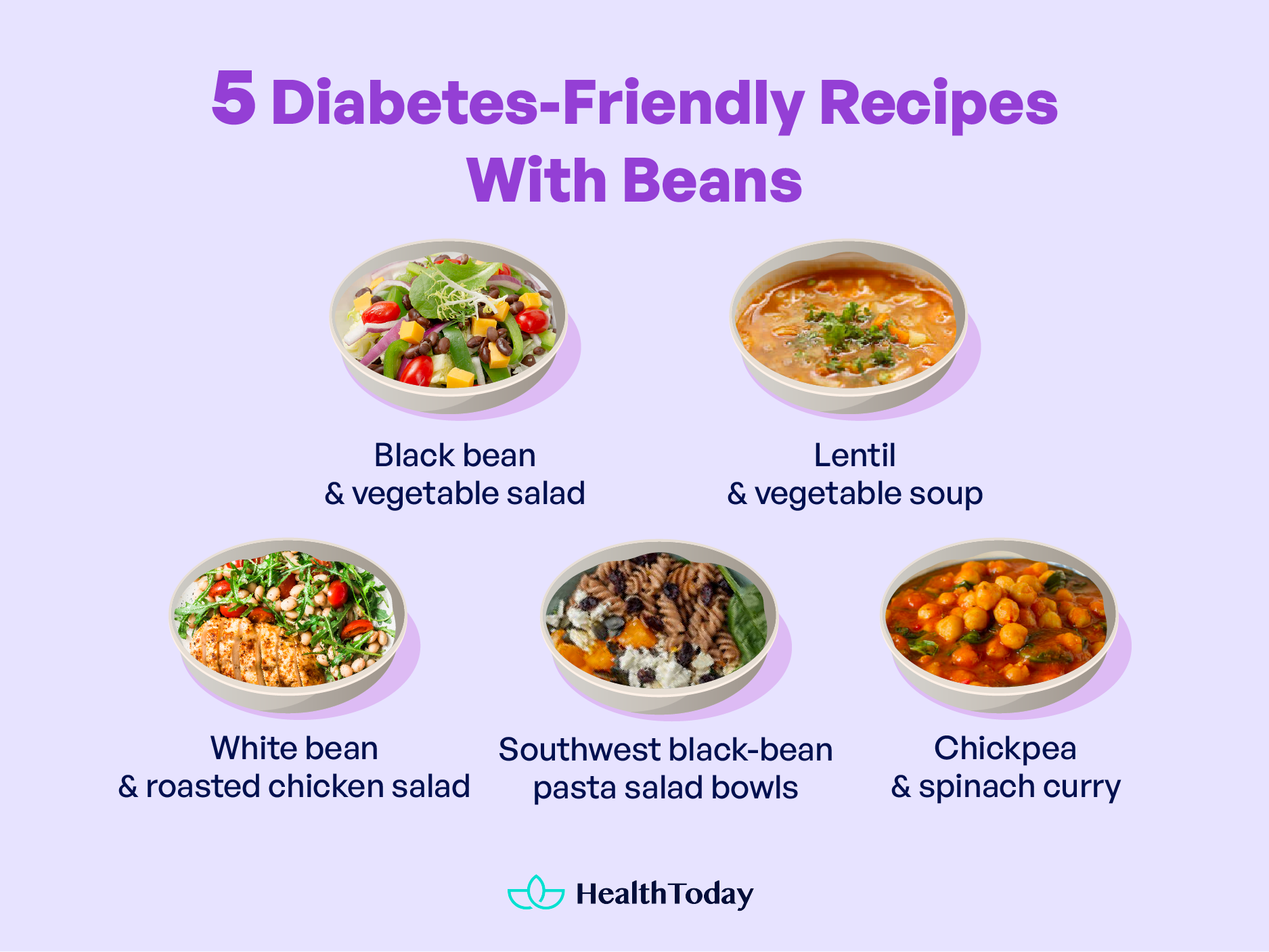
Black bean and vegetable salad
The classic black bean salad is ideal to take or prepare for spring days. A refreshing salad featuring black beans, cherry tomatoes, cucumber, bell pepper, red onion, and avocado tossed in a lime and olive oil dressing. High in fiber and nutrients, it’s a colorful and tasty option for a diabetes-friendly meal. Go to recipe
Lentil and vegetable soup
A hearty soup combining lentils with vegetables seasoned with cumin, paprika, and garlic. This nutrient-packed soup is a great source of fiber and protein, offering a warm and comforting meal for individuals managing diabetes. Go to recipe
White bean and roasted chicken salad
A protein-packed salad featuring white beans, shredded chicken, cherry tomatoes, red onion, and fresh basil, dressed with balsamic vinaigrette. This salad is not only delicious but also provides a balanced mix of nutrients for those with diabetes. Go to recipe
Southwest black-bean pasta salad bowls
Prepare a week’s worth of high-fiber lunches in just 20 minutes with a simple and delicious Southwestern-style pasta salad. The pasta, made with black beans, provides an impressive 14 grams of fiber per serving. Complemented by seasoned chicken strips and a flavorful corn salad, this meal-prep lunch is satisfying and convenient, making it your perfect lunch option. Go to recipe
Chickpea and spinach curry
A flavorful curry made with chickpeas, spinach, onions, tomatoes, and a blend of spices. Served over brown rice or quinoa, this dish is rich in plant-based proteins and fiber, making it a satisfying and blood sugar-friendly option. Get to recipe
You should diversify the recipes according to your preferences, adjusting them to moderate portions. When monitoring glucose levels, these foods must remain within the limits suggested by your doctor.
Are canned beans good for diabetics?
Canned beans can be a good option for diabetics when they choose varieties with no added sugars and low sodium. Rinsing the beans before use can further reduce the sodium content. It’s important to check labels carefully and opt for beans that align with diabetes dietary recommendations.
What foods can diabetics eat freely?
Diabetics should be careful in their portions. Some foods can be consumed a little more freely, such as non-starchy vegetables such as broccoli and cauliflower, and lean proteins, such as skinless poultry, fish, tofu, and legumes. Balance is essential to keep your diabetes condition under control.
Can a diabetic eat rice?
Yes, diabetics can include rice in their diet. However, it’s important to choose whole grains like brown rice or quinoa and practice portion control. It’s advisable to be mindful of the type of rice and incorporate it into a well-balanced meal.
How much beans can a diabetic eat per day?
The recommended amount of beans for a diabetic may vary depending on factors such as overall dietary needs, blood sugar levels, and other health considerations. Generally, one-half cup to one cup of beans several times a week can be part of a healthy diabetic diet. It is essential to monitor blood sugar levels and consult with health professionals or nutritionists to determine the amount that suits individual needs.
Summary
Beans are a superfood for people with diabetes. They offer protein, high fiber content, and low glycemic index properties. With over 100 varieties globally, including black, red, pinto, and chickpeas, beans provide a versatile and nutritious choice.
People with diabetes should focus on portion control and be mindful of food choices to ensure adequate nutrition and keep blood sugar levels under control. Careful consideration of bean types and preparation methods allows diabetics to enjoy their nutritional benefits, promoting overall health and diabetes control.





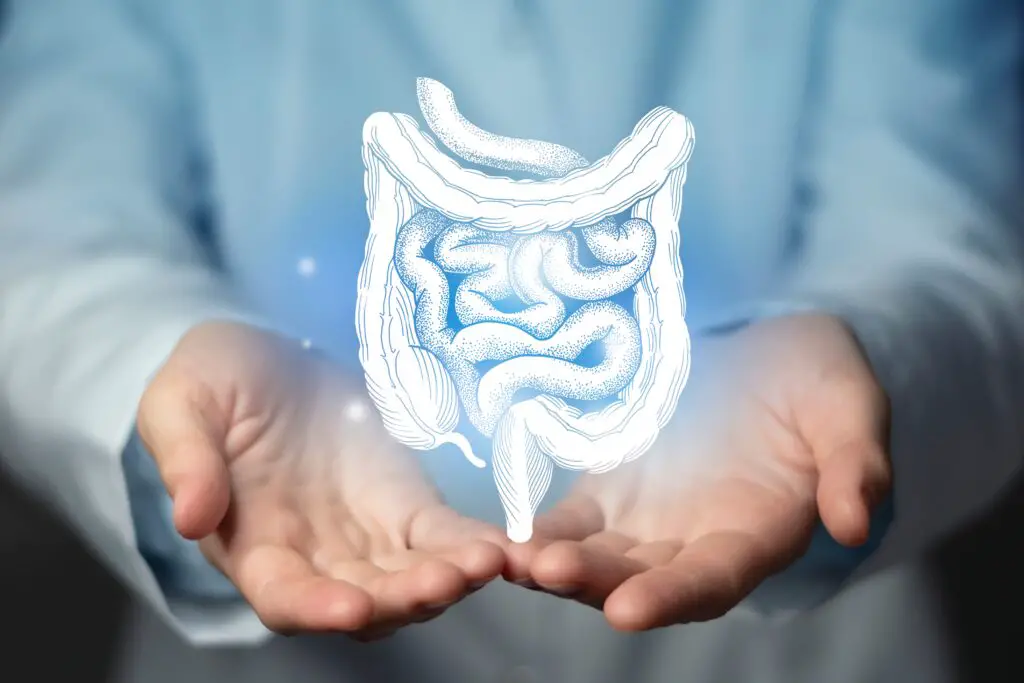

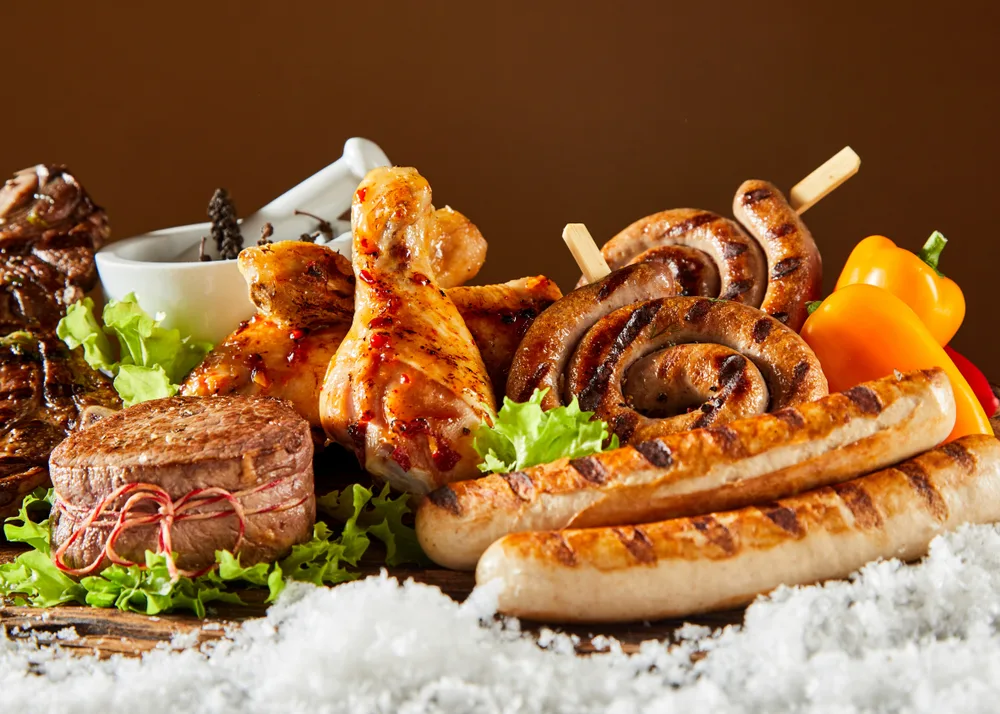
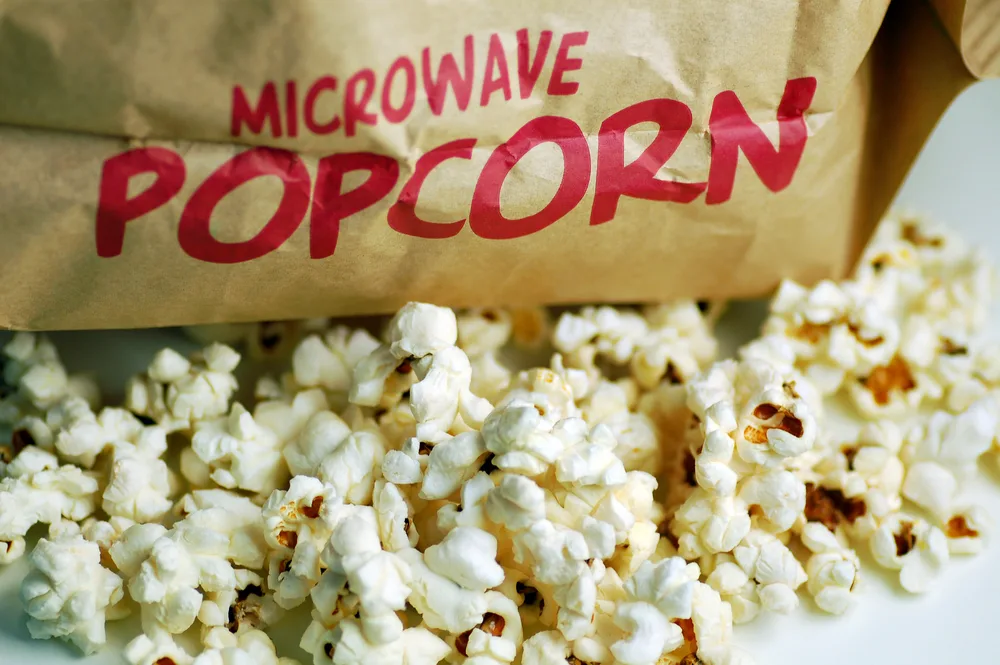
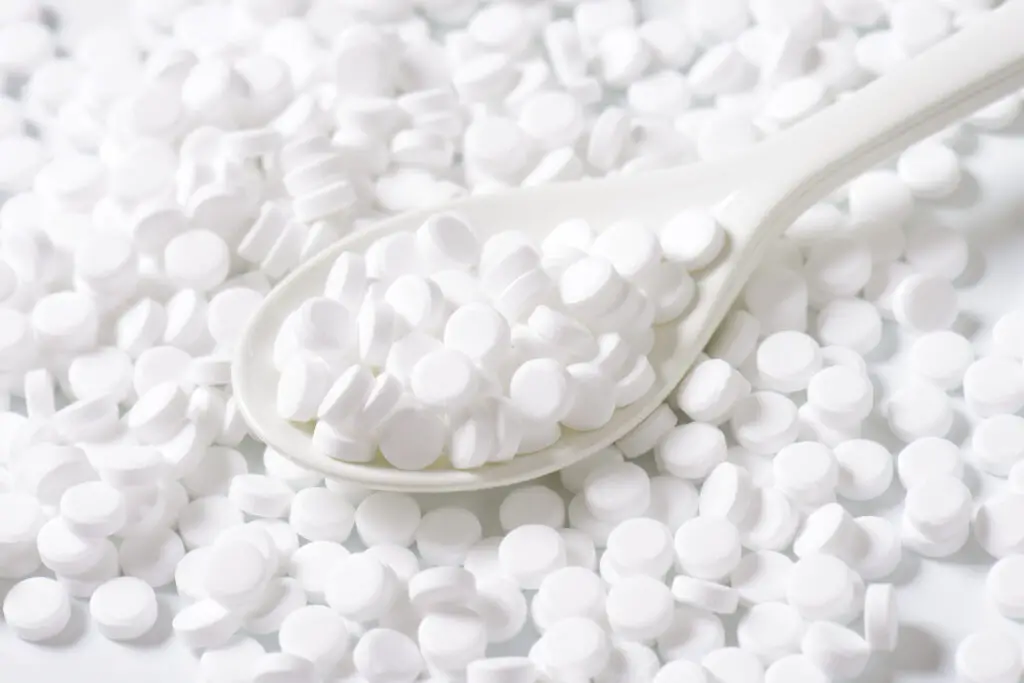


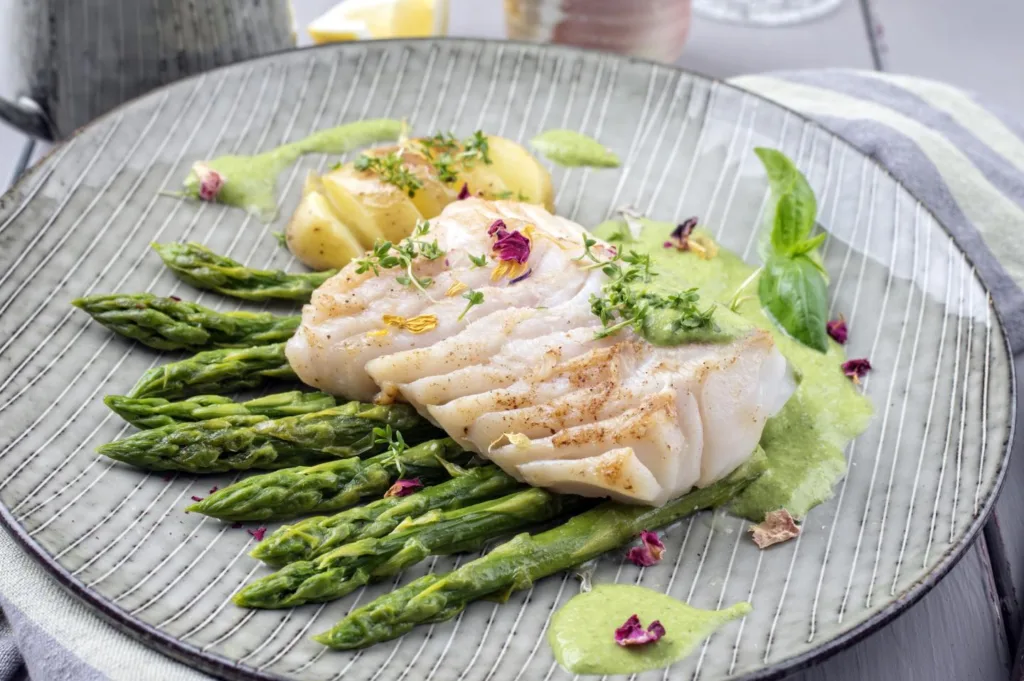

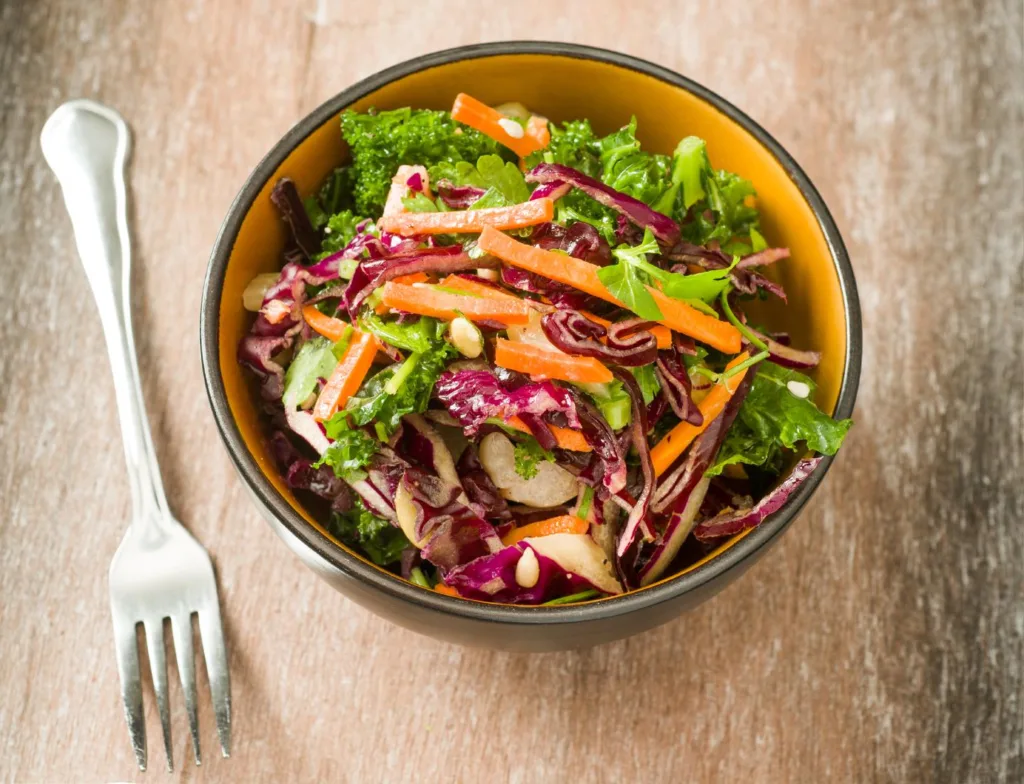
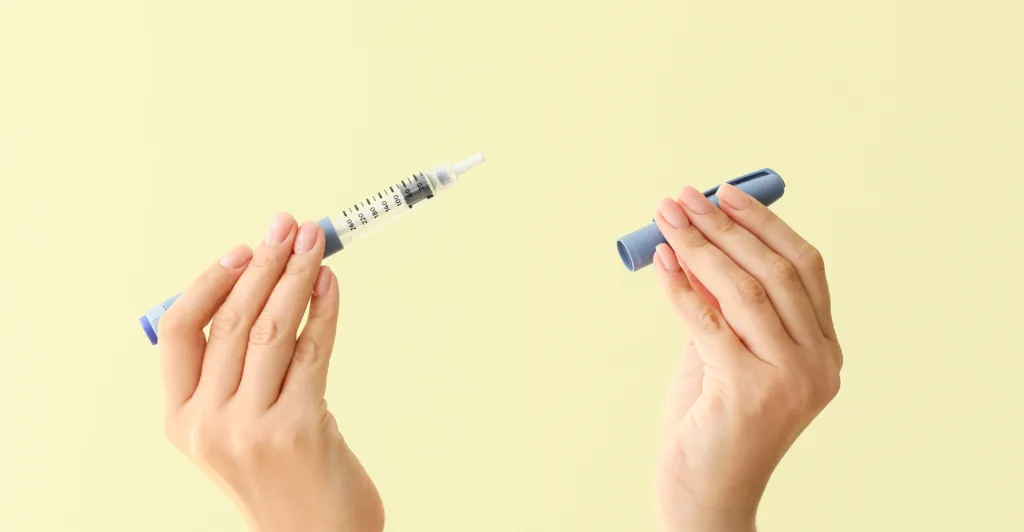

Comments
0